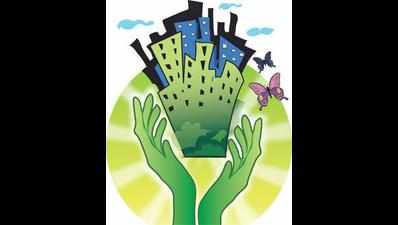- News
- City News
- ahmedabad News
- Urban sprawl choking Ahmedabad's green future
Trending
This story is from October 24, 2016
Urban sprawl choking Ahmedabad's green future
The civic body of Ahmedabad may be claiming the city is heading towards a `smart and green' future, but a true bird's-eye view by experts has exposed the `green' claims to be a far cry from reality.

(Representative image)
AHMEDABAD: The civic body of Ahmedabad may be claiming the city is heading towards a `smart and green' future, but a true bird's-eye view by experts has exposed the `green' claims to be a far cry from reality. Two researchers from IIT-Mumbai used Isro's Landsat images to show how the increasing `urban sprawl' was eating away into the green spaces of Ahmedabad, choking its lungs and gobbling up water bodies.The findings show a future filled with dust and concrete, unless authorities move from speech to action.
Satellite images reveal that in the city spread over 464 sq km, between 2009 and 2016, built-up area increased from 33% to 53%, while areas with vegetation decreased from 33% to 27%.
After having spent crores over developing policy documents and greening drives, and even collecting carbon credits for the same, it's time for the civic body to act upon the Landsat images which warn Amdavadis of a unsustainable future. The study conducted by Minakshi Goswami and M V Khire of the Centre of Studies in Resources Engineering, IIT, Mumbai, show that of the total land in the city, 43% is under residential use, while 15% is under industries.
“The UN's flagship cities conference, Habitat III, which met in Ecuador on October 17, had urban experts and policy makers deliberating on how to “prevent and contain urban sprawl“ as there were serious implications,“ says a senior Cept university professor.
Goswami and Khire point out in their study that, “The growth of the built-up area in the outer region of the city in 2009 was towards north, that is Gota and Gandhinagar, and east, which will be towards Changodar and Sanand.“
The study says , “Growth of the built up area in the outer region of the city in 2011, and now, is towards west (Oganj) and southeast, which is towards Vatva.“ “The north side is growing because of Gandhinagar. The development along west side is due to the large number of manufacturing industries along this corridor specially Sanand Tata nano plant, and the growth in southeast is due to the location of existing industrial estates in Vatva and Odhav ,“ says the study .
Times View
The 2013 development plan for Ahmedabad lays heavy emphasis on greenery and creating more open spaces in the city. Over the past three years, the Ahmedabad Municipal Corporation and the Ahmedabad Urban Development Authority have done precious little on these fronts. Many of the upcoming town planning schemes are devoid of the required number of trees and open spaces mandated by the Gujarat Town Planning Act. The city will head on the path of Delhi if more green areas are not created.
Satellite images reveal that in the city spread over 464 sq km, between 2009 and 2016, built-up area increased from 33% to 53%, while areas with vegetation decreased from 33% to 27%.
After having spent crores over developing policy documents and greening drives, and even collecting carbon credits for the same, it's time for the civic body to act upon the Landsat images which warn Amdavadis of a unsustainable future. The study conducted by Minakshi Goswami and M V Khire of the Centre of Studies in Resources Engineering, IIT, Mumbai, show that of the total land in the city, 43% is under residential use, while 15% is under industries.
“The UN's flagship cities conference, Habitat III, which met in Ecuador on October 17, had urban experts and policy makers deliberating on how to “prevent and contain urban sprawl“ as there were serious implications,“ says a senior Cept university professor.
“We should not take urban sprawl lightly as it has many negative consequences for re sidents and the environment, such as higher water and air pollution, increased traffic fatalities and jams, increased car dependency ,“ said the Cept professor. “It also results in higher taxes, increased runoff into lakes, harmful effects on human health, including higher rates of obesity , high blood pressure, hypertension and chronic diseases,“ he added.
Goswami and Khire point out in their study that, “The growth of the built-up area in the outer region of the city in 2009 was towards north, that is Gota and Gandhinagar, and east, which will be towards Changodar and Sanand.“
The study says , “Growth of the built up area in the outer region of the city in 2011, and now, is towards west (Oganj) and southeast, which is towards Vatva.“ “The north side is growing because of Gandhinagar. The development along west side is due to the large number of manufacturing industries along this corridor specially Sanand Tata nano plant, and the growth in southeast is due to the location of existing industrial estates in Vatva and Odhav ,“ says the study .
Times View
The 2013 development plan for Ahmedabad lays heavy emphasis on greenery and creating more open spaces in the city. Over the past three years, the Ahmedabad Municipal Corporation and the Ahmedabad Urban Development Authority have done precious little on these fronts. Many of the upcoming town planning schemes are devoid of the required number of trees and open spaces mandated by the Gujarat Town Planning Act. The city will head on the path of Delhi if more green areas are not created.
End of Article
FOLLOW US ON SOCIAL MEDIA











